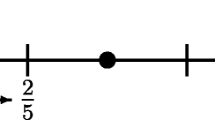Abstract
This paper describes a direct revelation mechanism for eliciting (a) decision makers’ range of subjective priors under Knightian uncertainty and their second-order introspective belief and (b) Bayesian decision makers’ range of posteriors and their subjective information structure.
Similar content being viewed by others
Notes
In robust Bayesian statistics, the elicitation of the set of priors is analogous to the elicitation of a single prior in Bayesian statistics (see Seidenfeld et al. 1995). Multi-prior models are part of the more general theory of imprecise probability, which allows for partial probability specifications. It is applicable when information is insufficient to identify a unique (prior) probability distribution (“it is useful for dealing with expert elicitation, because decision makers have a limited ability to determine their own subjective probabilities and might find that they can only provide an interval.” [Wikipedia, Imprecise probability]).
The term “second-order belief” is defined in the literature dealing with interactive decision making to describe one player’s belief of another player belief. It is also employed in the theory of decision making under uncertainty in the sense of its use here, namely to describe a decision maker’s belief over a set of priors (e.g., Seo 2009; Nascimento and Riella 2013; Giraud 2014).
See also Galaabaatar and Karni (2013).
Unlike the mechanism in this paper and the protocol of Chambers and Lambert, Prelec’s (2004) elicitation scheme is not designed for the elicitation of second-order beliefs and is, therefore, less pertinent for the problem under study.
This is the case of a subjective expected utility maximizing decision maker whose preference relation on the set of acts is incomplete, but restricted to the subset of constant acts the preference relation is complete.
The existence of \(\mu _{0},\) representing the decision maker’s second-order belief on the set of priors, is implied by the model of Karni and Safra (2016).
Kreps (1979) articulates this presumption as follows: “In many problems of individual choice, the choice is made in more than one stage. At early stages, the individual makes decisions which will constrain the choices that are feasible later. In effect, these early choices amount to choice of a subset of items from which subsequent choice will be made. This paper concerns choice among such opportunity sets, where the individual has a “desire for flexibility” which is “irrational” if the individual knows what his subsequent preferences will be” (Kreps 1979, p. 565). The focus of the discussion here is the subject’s subsequent beliefs rather than subsequent tastes.
The same analysis pertains to Bayesian subjects with private information structures.
It is easy to verify that the second-order condition is satisfied, so the first-order condition is necessary and sufficient for a maximum.
Assume that \({{\mathcal {H}}}\) is endowed with the topology of weak convergence, and denote by \(\Sigma \) the Borel sigma algebra on \({{\mathcal {H}}}\).
I assume that \({{\mathcal {F}}}\) together with the trace of \(\Sigma \) on \({{\mathcal {F}}\,}\) is the relevant measurable space.
For a recent review, see Chambers and Lambert (2017).
Note that \(\hat{F}\) is a second-order belief and is the same as \(\mu \) in this paper. Similarly, \(\hat{p}\) is a first-order belief and is the same as \( \pi \) in this paper. It is noteworthy, however, that the mechanism described in this paper does not require that the subject report his posterior belief.
References
Anscombe, F.J., Aumann, R.J.: A definition of subjective probability. Ann. Math. Stat. 34, 199–205 (1963)
Bewley, T.F.: Knightian decision theory: part I. Decis. Econ. Finance 25, 79–110 (2002)
Brier, G.W.: Verification of forecasts expressed in terms of probabilities. Mon. Weather Rev. 78, 1–3 (1950)
Chambers, C.P., Lambert, N.S.: Dynamically eliciting unobservable information. In: Proceedings of the 15th ACM Conference on Electronic Commerce, pp. 987–988 (2014)
Chambers, C.P., Lambert, N.S.: Introduction to dynamic belief elicitation. ACM SIGecom Exch. 14, 80–83 (2015)
Chambers, C.P., Lambert, N.S.: Dynamic belief elicitation. Unpublished manuscript (2017)
Dillenberger, D., Lleras, J.S., Sadowski, P., Takeoka, N.: A theory of subjective learning. J. Econ. Theory 153, 287–312 (2014)
Galaabaatar, T., Karni, E.: Subjective expected utility with incomplete preferences. Econometrica 81, 255–284 (2013)
Giraud, R.: Second order beliefs models of choice under omprecise risk. Theor. Econ. 9, 779–816 (2014)
Good, I.J.: Rational decisions. J. R. Stat. Soc. Ser. B (Methodol.) 14, 107–114 (1952)
Grether, D.M.: Financial incentive effects and individual decision making. Cal Tech, Social Science Working Paper 401 (1981)
Kadane, J.B., Winkler, R.L.: Separating probability elicitation from utility. J. Am. Stat. Assoc. 83, 357–363 (1988)
Karni, E.: A mechanism design for probability elicitation. Econometrica 77, 603–606 (2009)
Karni, E., Safra, Z.: A theory of stochastic choice under uncertainty. J. Math. Econ. 63, 164–173 (2016)
Kreps, D.M.: A representation theorem for ‘preference for flexibility’. Econometrica 47, 565–576 (1979)
Lu, J.: Random choice and private information. Econometrica 84, 1983–2027 (2016)
Nascimento, L., Riella, G.: Second order ambiguous beliefs. Econ. Theory 52, 1005–1037 (2013). https://doi.org/10.1007/s00199-011-0675-x
Prelec, D.: A Bayesian truth serum for subjective data. Science 306, 462–466 (2004)
Qu, X.: A mechanism for eliciting a probability distribution. Econ. Lett. 115, 399–400 (2012)
Roth, A.E., Malouf, M.W.K.: Game-theoretic models and the role of information in bargaining. Psychol. Rev. 86, 574–594 (1979)
Savage, L.J.: Elicitation of personal probabilities and expectations. J. Am. Stat. Assoc. 66, 783–801 (1971)
Seidenfeld, T., Schervish, M.J., Kadane, J.B.: A representation of partially ordered preferences. Ann. Stat. 23, 2168–2217 (1995)
Seo, K.: Ambiguity and second-order belief. Econometrica 77, 1575–1605 (2009)
Acknowledgements
I am grateful to Zvi Safra, Andrei Savochkin, Jay Lu, Christopher Chambers, Nicholas Lambert and an anonymous referee for their useful comments and suggestions.
Author information
Authors and Affiliations
Corresponding author
Rights and permissions
About this article
Cite this article
Karni, E. A mechanism for the elicitation of second-order belief and subjective information structure. Econ Theory 69, 217–232 (2020). https://doi.org/10.1007/s00199-018-1162-4
Received:
Accepted:
Published:
Issue Date:
DOI: https://doi.org/10.1007/s00199-018-1162-4
Keywords
- Second-order belief
- Subjective information structure
- Knightian uncertainty
- Probability elicitation
- Robust Bayesian statistics




